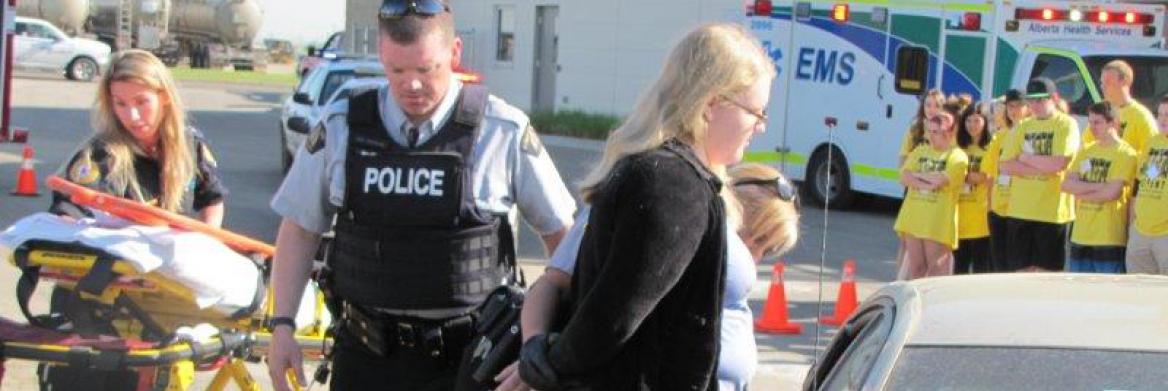A crowd of Grade 9 students gathers around the contorted wreckage of two cars. Shattered glass litters the ground as three bloodied actors twitch and moan in the crumpled vehicles.
Sirens blare as off-duty RCMP officers arrive on-scene to survey the damage. After a few minutes, they determine the cause of the collision: impaired driving.
This startlingly realistic crash scene is part of a program for ninth graders in Grande Prairie, Alberta. Known as Prevent Alcohol and Risk-Related Trauma in Youth (PARTY), the program is meant to shed light on the consequences of drinking and driving.
"It's that peak age — it's when kids are starting to drive and when alcohol starts to step into their lives — they're trying things and exploring," says Michelle Hodder, the program's co-ordinator from Alberta Health Services. "But the PARTY Program isn't just about drinking and driving, it's about providing information and fostering good decision-making."
The PARTY Program is a global initiative that began at the Sunnybrook Health Sciences Centre in 1986. It's now taught in more than 100 cities worldwide, including Grande Prairie, where it ran this past May over several days, educating more than 1,200 students in the area.
"A lot of people think when they call the police, we show up and save the day," says Cpl. Gary Weigum, from the Grande Prairie detachment. "That's not always the case."
Crash course
As the captivated students look on, volunteers from the fire department, emergency services, municipal enforcement services and a local funeral home arrive. Together, they work to show the students the most realistic depiction of a crash scene involving impairment.
The paramedics treat passengers who sustained serious injuries, declaring one of the young victims dead at the scene after a few minutes. To the shock of students, the young person is taken away in a hearse.
"Kids this age think they're invincible. They don't think that they may die or become paralyzed or get brain damage or face life-altering consequences," says Hodder. "We want kids to come, have fun and walk away equipped to make smarter choices."
Shortly after paramedics finish treating the injured passengers, the drunk driver — another actor — is arrested.
"When we make the driver turn around, put their hands behind their back and handcuff them while saying the memoranda of rights as they lean over the car — that's what surprises students the most," says Weigum. "It's the shock that it's real. They see the aftermath and the consequences."
The mock crash-scene takes about a half hour to complete, and afterwards, students are encouraged to ask questions at a debriefing session with first responders. Hodder says most of the questions are directed towards the RCMP, and touch on limits, the law and specific situations.
"As police, we emphasize how I'm the one who has to go to your house to explain to your parents that you died because you got in the car with a drunk driver," says Weigum. "We need to make it blunt. When we talk about our own personal experiences, I think it really brings these situations to life, and students can relate a little more."
Healthy choices
After the mock crash and debrief, students spend the rest of the day learning about the after-effects of drinking and drug related incidents. They watch short videos, participate in discussion groups, act out simulated scenarios and listen to presentations from injury survivors and motivational speakers.
"My favourite part was learning about the 'safe' percentage of alcohol — we got to wear the drunk goggles and try to walk in a straight line," says Grace Stephenson, a Grade 9 student from Grande Prairie. "It was different because we really experienced how our perception could be altered with drugs and alcohol."
Weigum says it's especially important to involve youth in discussions about alcohol. In Canada, motor vehicle collisions are the number-one killer of youth aged 16 to 25, and more than half of those accidents involve drugs or alcohol.
"Road safety and impaired driving is everyone's business, not just the police's, and it starts with the public," says Weigum. "If we can change one person's mind to make a better decision — that's why we do this."
Reprinted with permission from the Pony Express ().
